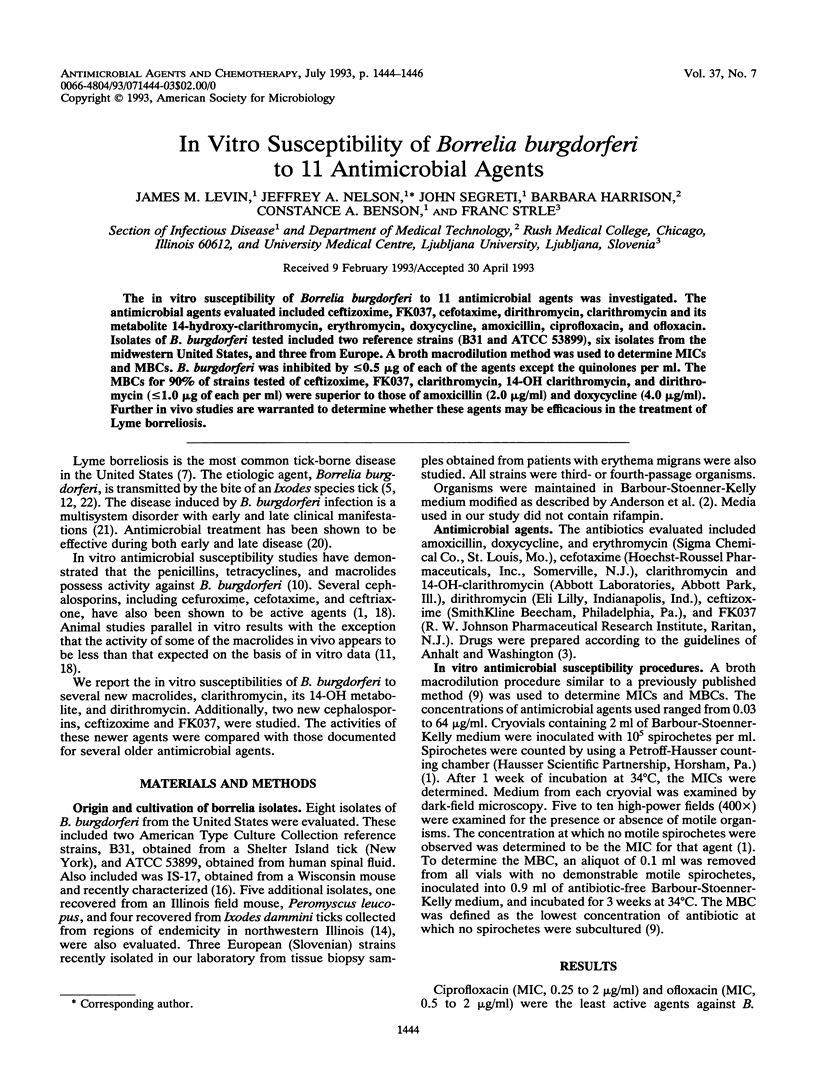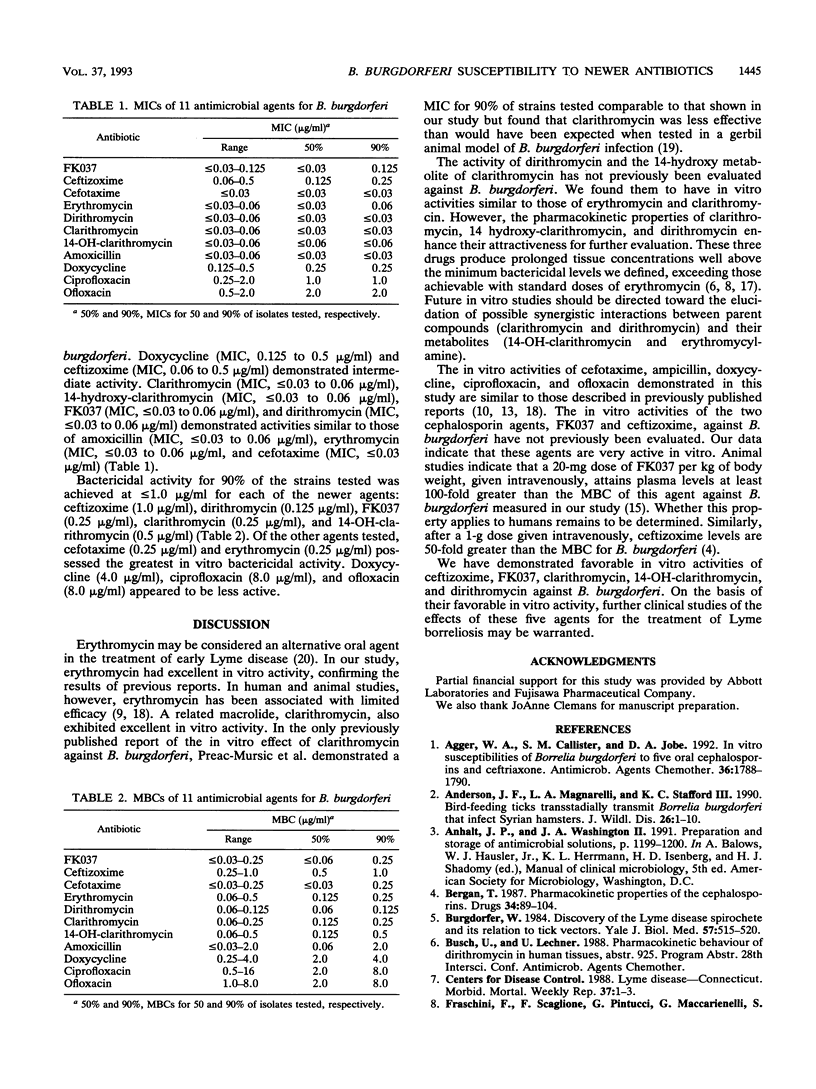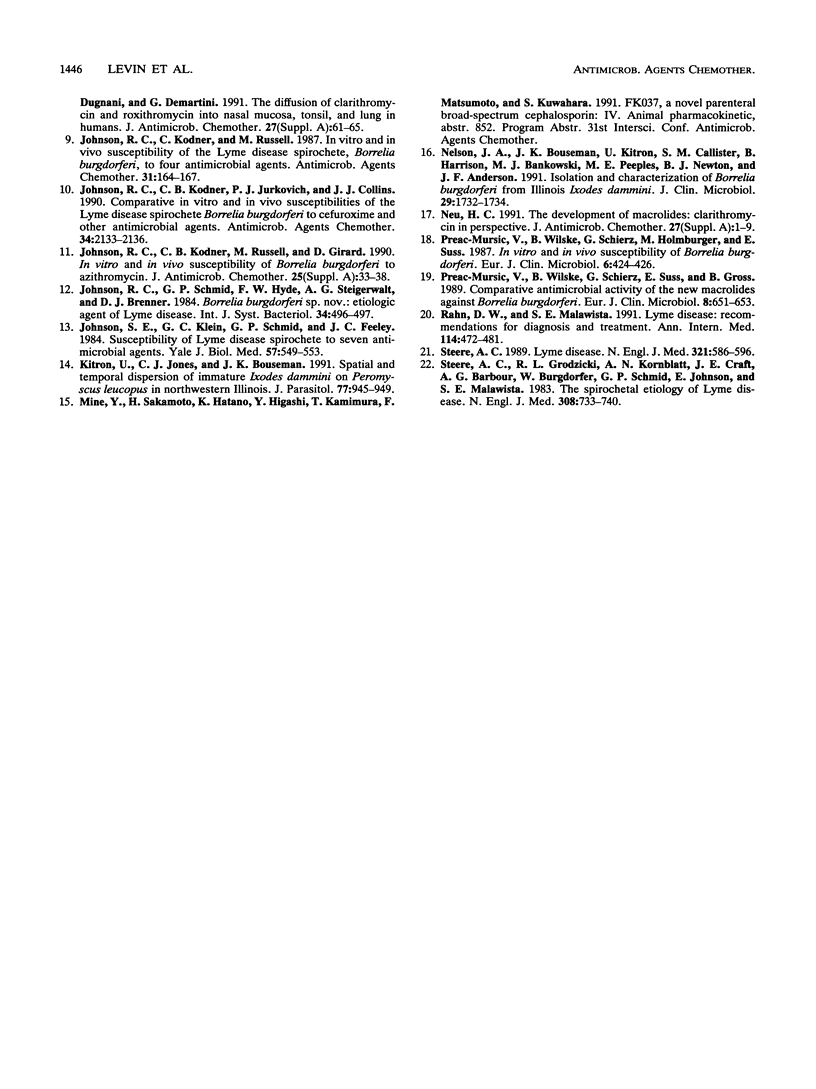Abstract
The in vitro susceptibility of Borrelia burgdorferi to 11 antimicrobial agents was investigated. The antimicrobial agents evaluated included ceftizoxime, FK037, cefotaxime, dirithromycin, clarithromycin and its metabolite 14-hydroxy-clarithromycin, erythromycin, doxycycline, amoxicillin, ciprofloxacin, and ofloxacin. Isolates of B. burgdorferi tested included two reference strains (B31 and ATCC 53899), six isolates from the midwestern United States, and three from Europe. A broth macrodilution method was used to determine MICs and MBCs. B. burgdorferi was inhibited by < or = 0.5 micrograms of each of the agents except the quinolones per ml. The MBCs for 90% of strains tested of ceftizoxime, FK037, clarithromycin, 14-OH clarithromycin, and dirithromycin (< or = 1.0 microgram of each per ml) were superior to those of amoxicillin (2.0 micrograms/ml) and doxycycline (4.0 micrograms/ml). Further in vivo studies are warranted to determine whether these agents may be efficacious in the treatment of Lyme borreliosis.
Full text
PDF


Selected References
These references are in PubMed. This may not be the complete list of references from this article.
- Agger W. A., Callister S. M., Jobe D. A. In vitro susceptibilities of Borrelia burgdorferi to five oral cephalosporins and ceftriaxone. Antimicrob Agents Chemother. 1992 Aug;36(8):1788–1790. doi: 10.1128/aac.36.8.1788. [DOI] [PMC free article] [PubMed] [Google Scholar]
- Anderson J. F., Magnarelli L. A., Stafford K. C., 3rd Bird-feeding ticks transstadially transmit Borrelia burgdorferi that infect Syrian hamsters. J Wildl Dis. 1990 Jan;26(1):1–10. doi: 10.7589/0090-3558-26.1.1. [DOI] [PubMed] [Google Scholar]
- Bergan T. Pharmacokinetic properties of the cephalosporins. Drugs. 1987;34 (Suppl 2):89–104. doi: 10.2165/00003495-198700342-00008. [DOI] [PubMed] [Google Scholar]
- Burgdorfer W. Discovery of the Lyme disease spirochete and its relation to tick vectors. Yale J Biol Med. 1984 Jul-Aug;57(4):515–520. [PMC free article] [PubMed] [Google Scholar]
- Fraschini F., Scaglione F., Pintucci G., Maccarinelli G., Dugnani S., Demartini G. The diffusion of clarithromycin and roxithromycin into nasal mucosa, tonsil and lung in humans. J Antimicrob Chemother. 1991 Feb;27 (Suppl A):61–65. doi: 10.1093/jac/27.suppl_a.61. [DOI] [PubMed] [Google Scholar]
- Johnson R. C., Kodner C. B., Jurkovich P. J., Collins J. J. Comparative in vitro and in vivo susceptibilities of the Lyme disease spirochete Borrelia burgdorferi to cefuroxime and other antimicrobial agents. Antimicrob Agents Chemother. 1990 Nov;34(11):2133–2136. doi: 10.1128/aac.34.11.2133. [DOI] [PMC free article] [PubMed] [Google Scholar]
- Johnson R. C., Kodner C., Russell M., Girard D. In-vitro and in-vivo susceptibility of Borrelia burgdorferi to azithromycin. J Antimicrob Chemother. 1990 Jan;25 (Suppl A):33–38. doi: 10.1093/jac/25.suppl_a.33. [DOI] [PubMed] [Google Scholar]
- Johnson R. C., Kodner C., Russell M. In vitro and in vivo susceptibility of the Lyme disease spirochete, Borrelia burgdorferi, to four antimicrobial agents. Antimicrob Agents Chemother. 1987 Feb;31(2):164–167. doi: 10.1128/aac.31.2.164. [DOI] [PMC free article] [PubMed] [Google Scholar]
- Johnson S. E., Klein G. C., Schmid G. P., Feeley J. C. Susceptibility of the Lyme disease spirochete to seven antimicrobial agents. Yale J Biol Med. 1984 Jul-Aug;57(4):549–553. [PMC free article] [PubMed] [Google Scholar]
- Kitron U., Jones C. J., Bouseman J. K. Spatial and temporal dispersion of immature Ixodes dammini on Peromyscus leucopus in northwestern Illinois. J Parasitol. 1991 Dec;77(6):945–949. [PubMed] [Google Scholar]
- Mursic V. P., Wilske B., Schierz G., Holmburger M., Süss E. In vitro and in vivo susceptibility of Borrelia burgdorferi. Eur J Clin Microbiol. 1987 Aug;6(4):424–426. doi: 10.1007/BF02013102. [DOI] [PubMed] [Google Scholar]
- Nelson J. A., Bouseman J. K., Kitron U., Callister S. M., Harrison B., Bankowski M. J., Peeples M. E., Newton B. J., Anderson J. F. Isolation and characterization of Borrelia burgdorferi from Illinois Ixodes dammini. J Clin Microbiol. 1991 Aug;29(8):1732–1734. doi: 10.1128/jcm.29.8.1732-1734.1991. [DOI] [PMC free article] [PubMed] [Google Scholar]
- Neu H. C. The development of macrolides: clarithromycin in perspective. J Antimicrob Chemother. 1991 Feb;27 (Suppl A):1–9. doi: 10.1093/jac/27.suppl_a.1. [DOI] [PubMed] [Google Scholar]
- Preac-Mursic V., Wilske B., Schierz G., Süss E., Gross B. Comparative antimicrobial activity of the new macrolides against Borrelia burgdorferi. Eur J Clin Microbiol Infect Dis. 1989 Jul;8(7):651–653. doi: 10.1007/BF01968150. [DOI] [PubMed] [Google Scholar]
- Rahn D. W., Malawista S. E. Lyme disease: recommendations for diagnosis and treatment. Ann Intern Med. 1991 Mar 15;114(6):472–481. doi: 10.7326/0003-4819-114-6-472. [DOI] [PubMed] [Google Scholar]
- Steere A. C., Grodzicki R. L., Kornblatt A. N., Craft J. E., Barbour A. G., Burgdorfer W., Schmid G. P., Johnson E., Malawista S. E. The spirochetal etiology of Lyme disease. N Engl J Med. 1983 Mar 31;308(13):733–740. doi: 10.1056/NEJM198303313081301. [DOI] [PubMed] [Google Scholar]
- Steere A. C. Lyme disease. N Engl J Med. 1989 Aug 31;321(9):586–596. doi: 10.1056/NEJM198908313210906. [DOI] [PubMed] [Google Scholar]


